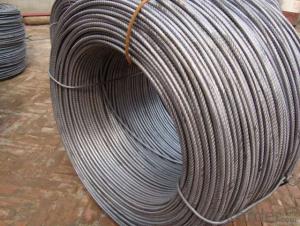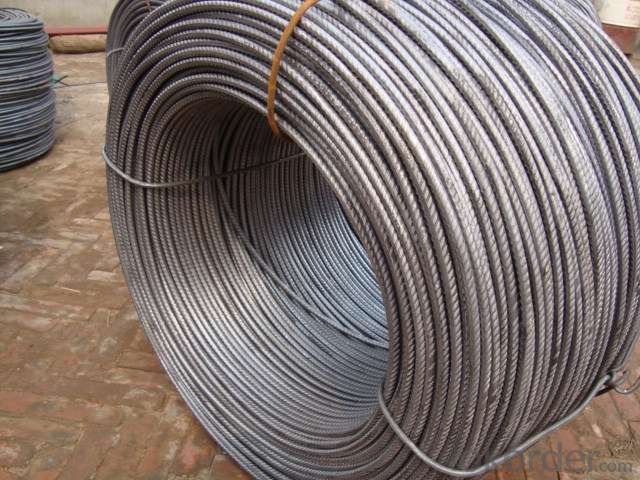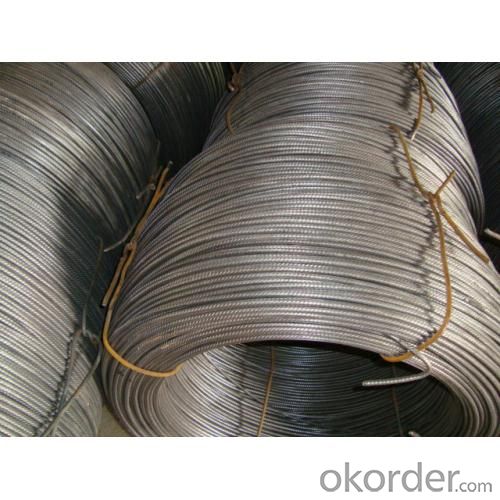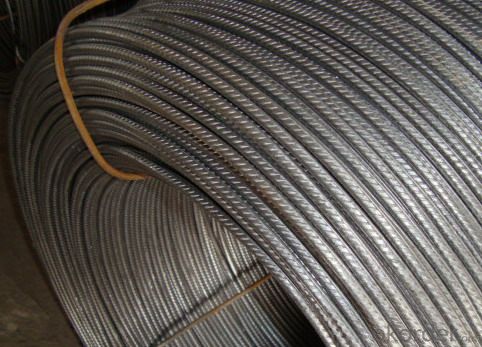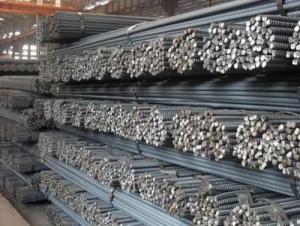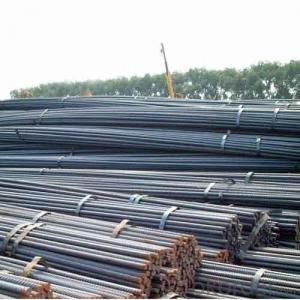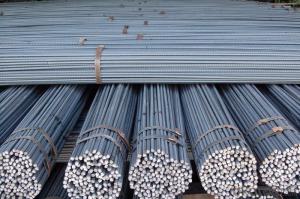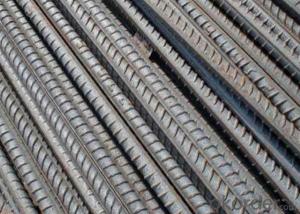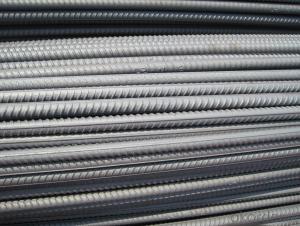High Quality Steel Deformed Bar HRB400 6/8/10mm
- Loading Port:
- Tianjin
- Payment Terms:
- TT or LC
- Min Order Qty:
- 50 m.t
- Supply Capability:
- 10000 m.t/month
OKorder Service Pledge
OKorder Financial Service
You Might Also Like
High Quality Steel Deformed Bar HRB400 6/8/10mm
Product Description:
Specifications of High Quality Steel Deformed Bar HRB400 6/8/10mm:
Standard | GB | HRB400 | |
Diameter | 6mm,8mm,10mm | ||
Length | In coils | ||
Place of origin | Hebei, China mainland | ||
Advantages | exact size, regular package, chemical and mechanical properties are stable. | ||
Type | Hot rolled deformed steel bar | ||
Chemical Composition of High Quality Steel Deformed Bar HRB400 6/8/10mm: (Please kindly find our chemistry of our material based on HRB400 as below for your information)
Grade | Technical data of the original chemical composition (%) | ||||||
C | Mn | Si | S | P | V | ||
HRB400 | ≤0.25 | ≤1.60 | ≤0.80 | ≤0.045 | ≤0.045 | 0.04-0.12 | |
Physical capability | |||||||
Yield Strength (N/cm²) | Tensile Strength (N/cm²) | Elongation (%) | |||||
≥400 | ≥570 | ≥14 | |||||
Theoretical weight and section area of High Quality Steel Deformed Bar HRB400 6/8/10mm as below for your information:
Diameter(mm) | Section area (mm²) | Mass(kg/m) | Weight of 12m bar(kg) |
6 | 28.27 | 0.222 | 2.664 |
8 | 50.27 | 0.395 | 4.74 |
10 | 78.54 | 0.617 | 7.404 |
Usage and Applications of High Quality Steel Deformed Bar HRB400 6/8/10mm:
Deformed bar is widely used in buildings, bridges, roads and other engineering construction. Big to highways, railways, bridges, culverts, tunnels, public facilities such as flood control, dam, small to housing construction, beam, column, wall and the foundation of the plate, deformed bar is an integral structure material. With the development of world economy and the vigorous development of infrastructure construction, real estate, the demand for deformed bar will be larger and larger.
Packaging & Delivery of High Quality Steel Deformed Bar HRB400 6/8/10mm:
Packaging Detail: products are packed in bundle and then shipped by container or bulk vessel, deformed bar is usually naked strapping delivery, when storing, please pay attention to moisture proof. The performance of rust will produce adverse effect.
Each bundle weight: 2-3MT, or as required
Payment term: TT or L/C
Delivery Detail: within 45 days after received advanced payment or LC.
Label: to be specified by customer, generally, each bundle has 1-2 labels
Trade terms: FOB, CFR, CIF
FAQ:
Q1: Why buy Materials & Equipment from OKorder.com?
A1: All products offered byOKorder.com are carefully selected from China's most reliable manufacturing enterprises. Through its ISO certifications, OKorder.com adheres to the highest standards and a commitment to supply chain safety and customer satisfaction.
Q2: How do we guarantee the quality of our products?
A2: We have established an advanced quality management system which conducts strict quality tests at every step, from raw materials to the final product. At the same time, we provide extensive follow-up service assurances as required.
Q3: How soon can we receive the product after purchase?
A3: Within three days of placing an order, we will arrange production. The shipping date is dependent upon the quatity, how many sizes you want and the plan of production, but is typically 1 month to 2 month days from the beginning of production.
Images of High Quality Steel Deformed Bar HRB400 6/8/10mm:
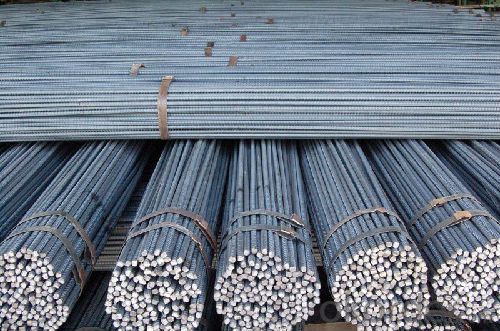
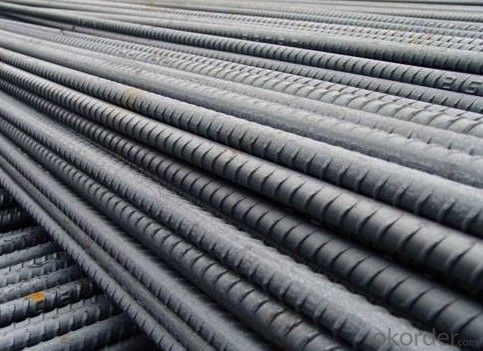
*If you would like to get our price, please inform us the size, standard/material and quantity. Thank you very much for your attention.
- Q: What are the marking of the steel bars on the mills? Which factory is the 2LG16 thread?
- 2LG16 thread manufacturer is the Laiwu iron and steel works, referred to as "Laiwu Steel", the letter "LG", indicating that the steel produced by the diameter of 16 of the two grade thread steel.
- Q: How do steel rebars affect the overall sustainability of a structure?
- The overall sustainability of a structure is significantly influenced by steel rebars. To begin with, the utilization of steel rebars adds to the building's strength and durability, ensuring its longevity and decreasing the need for frequent repairs or replacements. As a result, the consumption of raw materials and energy required for construction is reduced, making the structure more sustainable. Moreover, steel rebars aid in improving the structural integrity of a building, rendering it more resilient to natural disasters like earthquakes and hurricanes. By enhancing the safety and resilience of the structure, steel rebars minimize the potential for damage and loss, thereby reducing the environmental impact associated with reconstruction and waste generation. Additionally, at the end of a building's life cycle, steel rebars can be recycled. Steel is highly recyclable, and the reuse of steel rebars significantly decreases the demand for virgin steel production and the related carbon emissions. Steel recycling also conserves natural resources and reduces landfill waste, making it a more sustainable alternative to using other materials. Furthermore, the incorporation of steel rebars in structures allows for greater design flexibility and adaptability. This implies that buildings can be easily modified or repurposed, reducing the necessity for demolition and reconstruction. The ability to repurpose existing structures reduces waste and energy consumption, contributing to the overall sustainability of the built environment. In conclusion, steel rebars have a positive impact on the overall sustainability of a structure through their durability, strength, and recyclability. By enhancing the longevity, safety, and adaptability of a building, steel rebars decrease the environmental impact associated with construction, maintenance, and demolition.
- Q: What is the role of steel rebars in preventing structural failures?
- The construction industry relies heavily on steel rebars to prevent structural failures. These reinforcing bars, also known as steel rebars, are vital for strengthening and reinforcing concrete structures, ensuring their durability and ability to withstand various forces. One of the main functions of steel rebars is to improve the tensile strength of concrete. While concrete is excellent for compression, it lacks strength in tension. By incorporating steel rebars into concrete structures, this weakness can be overcome by providing resistance to tensile forces. Acting as reinforcements, steel rebars effectively absorb and distribute tensile stresses throughout the structure, preventing the formation of cracks and fractures, and ultimately averting structural failures. Moreover, steel rebars play a critical role in enhancing overall structural stability and preventing failures. By reinforcing concrete, rebars enhance the structural integrity and increase the load-bearing capacity of the structure. This allows the structure to withstand heavier loads and forces, including those caused by natural disasters, extreme weather conditions, or human activities. Steel rebars are also indispensable in preventing structural failures resulting from corrosion. Concrete structures are exposed to various environmental factors, such as moisture, chemicals, and salts, which can cause corrosion of the reinforcing steel. However, as steel rebars are typically coated or protected with anti-corrosive materials, they act as a barrier against corrosion, ensuring the long-term durability and integrity of the structure. Furthermore, steel rebars contribute to preventing structural failures by providing stability during construction. They are strategically placed within the concrete forms at critical points and areas susceptible to high stress. This ensures that the structure remains stable and can withstand the loads and forces exerted during and after construction. In conclusion, the role of steel rebars in preventing structural failures is multifaceted. They enhance the tensile strength of concrete, increase structural stability, prevent corrosion, and provide stability during construction. By reinforcing concrete, steel rebars significantly contribute to the overall strength, durability, and safety of structures, ultimately averting structural failures and ensuring the longevity of the built environment.
- Q: What are the guidelines for proper cover thickness of steel rebars in concrete structures?
- Ensuring the durability and structural integrity of concrete structures heavily relies on adhering to the guidelines for proper cover thickness of steel rebars. Below are the general guidelines to consider: 1. Local building codes and regulations: It is crucial to refer to the building codes and regulations applicable in the area as they provide detailed specifications for the cover thickness of steel rebars in concrete structures. These codes are based on extensive research, testing, and engineering standards, guaranteeing the safety and longevity of the structure. 2. Environmental factors: The environmental conditions in which the structure will be situated should be taken into account. Variables like exposure to corrosive substances, humidity, temperature fluctuations, and seismic activity can influence the necessary cover thickness. In more challenging environments, it may be necessary to use thicker covers to adequately protect against corrosion. 3. Rebar diameter: The diameter of the steel rebars also influences the appropriate cover thickness. Smaller diameter rebars may require a thinner cover compared to larger diameter rebars to maintain strength and prevent corrosion. 4. Structural design considerations: When determining the cover thickness, the design of the concrete structure, including its load-bearing capacity, reinforcement layout, and anticipated stresses, must be considered. Consulting with a structural engineer is vital to accurately determine the cover thickness based on the specific design requirements. 5. Concrete quality: The quality and type of concrete used in construction also impact the necessary cover thickness. Higher-grade concrete with superior corrosion resistance may allow for a thinner cover, while lower-grade concrete may necessitate a thicker cover to provide adequate protection to the rebars. 6. Construction process: The construction process itself can affect the cover thickness. Proper placement and compaction of the concrete, as well as careful handling of the rebars during installation, are essential to maintain the desired cover thickness. Construction workers and contractors should receive training and possess knowledge of the correct procedures to achieve the appropriate cover thickness. Adhering to these guidelines is crucial to ensure the long-term durability, safety, and performance of concrete structures. It is always recommended to consult with a qualified structural engineer or other relevant professionals to determine the specific cover thickness requirements for a particular project.
- Q: What is the resistance of steel rebars against acid attacks?
- Due to the protective layer of rust that forms on their surface, steel rebars exhibit a high resistance to acid attacks. This layer, commonly known as iron oxide, acts as a barrier, effectively preventing direct contact and corrosion between the steel and the acid. Furthermore, the steel rebars' resistance to acid attacks is enhanced by their high carbon content, which results in the formation of a protective film that provides additional shielding from acid damage. However, it is important to bear in mind that extended exposure to highly concentrated or corrosive acids may still cause some degree of corrosion, although at a slower pace compared to other metals. Therefore, it is recommended to carefully choose the appropriate grade of steel rebar and implement supplementary protective measures, such as coatings or concrete coverings, in order to ensure optimal resistance against acid attacks in specific applications.
- Q: What is the role of steel rebars in reducing concrete shrinkage?
- Steel rebars play a crucial role in reducing concrete shrinkage by providing reinforcement and added strength to the concrete structure. When concrete cures, it undergoes a process called hydration, where it loses water and shrinks in volume. This shrinkage can lead to cracking and overall structural instability. By placing steel rebars within the concrete, they act as a reinforcement and help to counteract the forces of shrinkage. The rebars provide tensile strength, which is the ability to resist pulling or stretching forces. As the concrete shrinks, the rebars hold it together and prevent excessive cracking. Additionally, the steel rebars help to distribute the load more evenly throughout the concrete structure. This reduces the concentration of stress in specific areas, further minimizing the potential for shrinkage-related cracking. Furthermore, steel rebars can also act as a thermal conductor, allowing heat to dissipate more evenly throughout the concrete. This helps to prevent temperature differentials within the structure, which can lead to differential shrinkage and subsequent cracking. In summary, the role of steel rebars in reducing concrete shrinkage is to provide reinforcement, resist tensile forces, distribute loads, and regulate temperature differentials. By doing so, they enhance the overall durability and stability of the concrete structure, minimizing the negative effects of shrinkage.
- Q: Can steel rebars be used in bridge construction projects?
- Yes, steel rebars can be used in bridge construction projects. Steel rebars are commonly used as reinforcement in concrete structures, including bridges. They provide strength and stability to the bridge, enhancing its load-bearing capacity and resistance to various forces such as tension, compression, and bending. Steel rebars are highly durable and can withstand harsh environmental conditions, making them an ideal choice for bridge construction where longevity and structural integrity are crucial. Additionally, steel rebars can be easily shaped and bent to suit the specific design requirements of the bridge, allowing for flexible and efficient construction. Overall, steel rebars are widely accepted and commonly used in bridge construction projects due to their excellent mechanical properties and reliability.
- Q: Can steel rebars be used in structures with high resistance to earthquakes?
- Structures with high resistance to earthquakes can make use of steel rebars. These rebars are commonly incorporated in reinforced concrete structures to enhance strength and durability. In areas prone to earthquakes, it is crucial to design and construct buildings capable of withstanding seismic forces. Properly incorporating steel rebars into the structural design can contribute to improving the overall seismic performance of a building. In earthquake-resistant structures, steel rebars offer several advantages. Firstly, they increase the tensile strength of concrete, which is typically weak in tension. This reinforcement helps prevent cracking and failure of the concrete during seismic events. Additionally, steel rebars improve the ductility of the structure, allowing it to absorb and dissipate energy during earthquakes. This ductile behavior helps minimize structural damage and ensures the building remains stable and safe. Moreover, steel rebars can be combined with other seismic design techniques to enhance the overall performance of the structure. For instance, they can be used in conjunction with specialized concrete mixes like high-strength or fiber-reinforced concrete to further improve seismic resistance. Advanced structural systems such as moment frames or shear walls can also be integrated with steel rebars to provide even greater earthquake resistance. However, it is important to note that the earthquake resistance of a structure does not solely depend on the use of steel rebars. Proper design, construction techniques, and adherence to seismic building codes are equally crucial factors. Engineers must consider various aspects, including the building's location, soil conditions, and anticipated seismic loads, to ensure the structural integrity and safety of the building. In conclusion, steel rebars can effectively enhance the earthquake resistance of structures. By incorporating them into reinforced concrete structures, the tensile strength and ductility are improved, enabling the building to withstand seismic forces. Nevertheless, it is essential to implement comprehensive seismic design strategies and adhere to building codes to ensure the overall safety and performance of the structure.
- Q: Are steel rebars suitable for use in structures with high wind loads?
- Yes, steel rebars are suitable for use in structures with high wind loads. Steel rebars, also known as reinforcing bars, are commonly used in construction to provide strength and stability to reinforced concrete structures. They are designed to withstand high tensile forces and are an essential component in ensuring the structural integrity of buildings, especially in areas prone to high wind loads. Steel rebars offer several advantages that make them suitable for use in structures with high wind loads. Firstly, steel has high tensile strength, allowing it to resist the forces generated by wind loads. Unlike other materials like timber or concrete, steel rebars have excellent ductility, making them capable of absorbing and redistributing the energy caused by wind-induced vibrations. Secondly, steel rebars are highly durable and resistant to corrosion, which is essential for structures exposed to harsh weather conditions, including high winds. The use of steel rebars prevents the risk of deterioration or weakening of the structure over time due to wind-induced stresses. Thirdly, steel rebars can be easily molded and shaped to fit the specific design requirements of the structure. This flexibility allows engineers to design and construct buildings that can withstand the varying wind loads experienced in different regions. Overall, steel rebars are a suitable choice for structures with high wind loads due to their high tensile strength, durability, and resistance to corrosion. They provide the necessary reinforcement needed to ensure the longevity and safety of the structure in challenging wind conditions.
- Q: What is the length and size of thread steel?
- Domestic sales of domestic thread steel, if the contract does not specify requirements, usually fixed length of 9m, 12m two length.
Send your message to us
High Quality Steel Deformed Bar HRB400 6/8/10mm
- Loading Port:
- Tianjin
- Payment Terms:
- TT or LC
- Min Order Qty:
- 50 m.t
- Supply Capability:
- 10000 m.t/month
OKorder Service Pledge
OKorder Financial Service
Similar products
Hot products
Hot Searches
Related keywords
